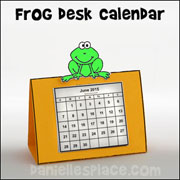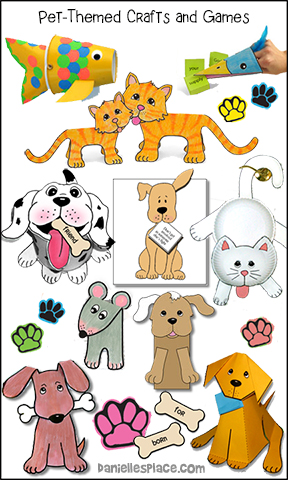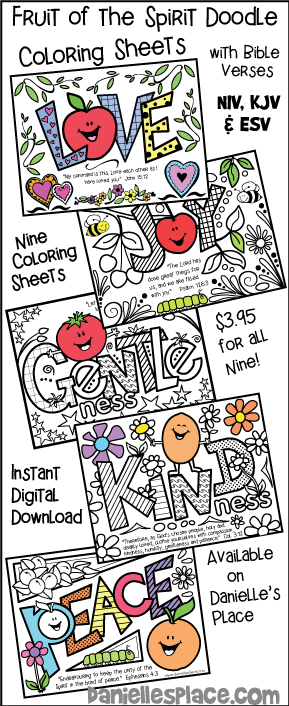Frog Crafts and Learning Activities for Kids
How to Make Crafts and Activities Relating to Frogs
Darwin's Frog with Baby in it's Mouth Educational Craft for Kids
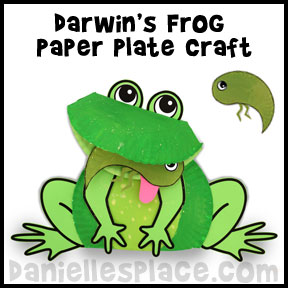
Read The Mystery of Darwin's Frog and learn about
this amazing little frog.
This amazing frog is famous because it is the only known species to raise it's young in it's vocal sacs or mouth. Discovered by Charles Darwin in 1834 in Chile the little frog is endangered due to a frog-killing fungus that is sweeping across South America. Have your children watch video's and read books about this frog and then make the frog craft.
What you will need:
Dinner-sized Paper Plates and Snack-sized Paper Plates, Green, Pink, and White Paint (or other colors), Scissors, and Glue
How to Make the Paper Plate Frog Craft:

1. To make the frog's mouth and head fold a paper plate in half and cut 2-inch slits on both sides of paper plate at the fold. Fold up the corners at the slits on the back of the paper plate. Fold back the corners on the front of the paper plate at the slits so they go to the back and over the back flaps. Glue them down. Crease the front center of the paper plate to make the frog's snout. Paint the head using a dark color for the outside and lighter color for the inside of the mouth. (Note - You don't have to fold down the sides of the head. This just make the mouth so it opens better.)
2. To make the body cut about one inch off one side of a paper plate. The cut edge is the bottom of the body. Darwin's frogs come in different colors such as brown, green and white. Study different pictures of the frog and decide what color you would like to make your frog. Then paint it to look like a Darwin frog.
3. Glue the head of the frog onto the body as shown in the picture.
4. Draw legs, arms, and the eye things on green paper as shown in the picture above. Glue them to body.

5. Draw eyes on a piece of white paper, cut them out, and glue them to the frog. (A Printable Pattern for the eyes is available to members.)
6. To make the tadpoles draw an "S" across the width of a snack-sized paper plate and cut on the line. This will make two tadpoles. Paint the tadpoles and then glue on eyes. (Printable Patterns for the eyes, and tadpoles are available to members.)
©2013, Digital by Design, Inc. -See Copyright Information
How to Use the Craft:
1. Learning Activity - Use the tadpoles to reinforce what your children have learned about Darwin's frog. Have them write facts about the frog on the underside of the tadpoles and place them in the frog's mouth.
2. Bulletin Board Display - Use the tadpoles and frog as a bulletin board display. Have each child write a fact about Darwin's frog on a piece of paper and tack it to your bulletin board with a tadpole.
3. Watch National Geographic Video "The World's Weirdest: Frog Father "Spits Out" Young.
Paper Plate Frog Craft for Kids
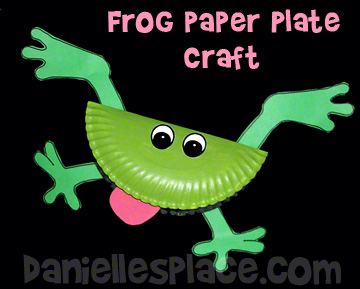
What you will need:
Dinner-sized Paper Plates, Pink or Red Construction Paper, White and Green Paper or Green Foam Sheets, Paint - Lime Sorbet, Tacky Glue or Elmer's Tacky Glue
How to Make the Paper Plate Frog:
1. Fold a paper plate in half. Paint the outside green and the inside black. Cut a red tongue from construction paper. Draw feet and legs on green construction paper and cut them out. Draw eyes on white printer paper and cut them out. (Patterns for the Feet are available to members only.)
2. Glue the legs and feet to the bottom of the folded paper plate as shown. Glue the tongue to the inside. Glue the eyes on the top.
Feed the Frog Math Game
Before class prepare the Paper Plate Frog. Print out the fly patterns and cut them apart.
Decide which math family you want to work on and write the multiples of that math family on the back of the flies, on number per fly. Also write some extra numbers that don't match that fact family. Place the flies in a bag. Have your children take turns picking out a fly from the bag. Ask the child to look at the number on the back of the fly and tell you if it belongs to the fact family you are studying. If it does, he gets to feed it to the frog. Keep playing until all the children have had a turn.
©2005, Digital by Design, Inc. -See Copyright Information
Frog Milk Jug Tabletop Garbage Container

What you will need:
Green Tissue Paper, Ceramcoat Acrylic Paint - Lime Sorbet, or Green Spray Paint
Printer Paper
Tacky Glue or Elmer's Tacky Glue
Scissors with Sharp Point or Knife, Duck Tape and a Paint Brush
How to Make This Toady Awesome Craft:
1. Wash and dry the plastic milk jug. Cut a line from side to side at the top of the jug about one inch below where the jug starts to form the top of the jug as shown in the picture.
2. Cut a one inch section from the handle so that the top of the jug can be bent back and the mouth opened. Tape the remaining handle together so that the mouth stays open.
3. You can add color different ways. Small pieces of crepe paper were glued to give this toad color. Add a small amount of water to white glue and paint it on the jug. Stick small pieces of crepe on top of the glue. Add more glue and over lap the pieces until the whole jug is covered. You may also want to add some to the inside of the jug. The belly of the toad is also made with crepe paper.
4. Cut arms, legs, and a lily pad from green fun foam and glue them to the jug.
5. The eyes where made with white fun foam and green goodly eyes. The tongue was cut from red fun foam.
6. Print out the "Feed me!" sign pattern, cut out a sign and glue it to the frog's hands.
©2010, Digital by Design, Inc. -See Copyright Information
Paper Frog with Note Paper Bible Craft for Children
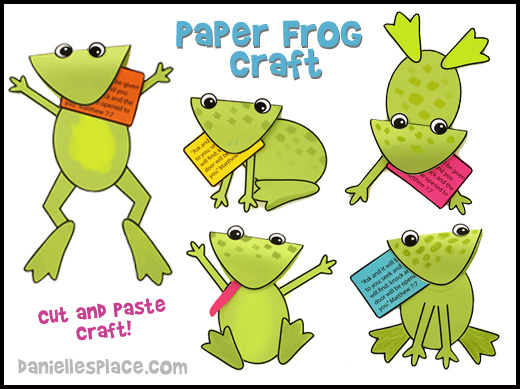
These adorable little frogs can be used in many ways. The head is made from a folded piece of paper so that the mouth opens and closes. Children can create their own designs by adding features such as a tongue, spots, and pompom eyes, and coloring them different colors.
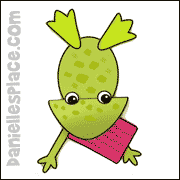
What you will need:
Card stock
Glue
Crayons, Markers or Colored Pencils
Pompoms and Goodly Eyes (Optional)
How to Make the Paper Frogs:
1. Print out the patterns onto card stock
2. Use the diagram sheet to see how to assemble the frogs. Children may also find other ways to put them together. The diagram sheet is just to give them some ideas.
3. Cut out the pattern parts and glue them together. Fold the head piece in half to form the mouth. Children may want to add a long tongue, spots, pompoms for eyes, or goodly eyes.
4. Tape the note card in the frog's mouth. To give the head and mouth depth, scrunch up the top of the folded head when taping it to the back of the mouth.
These Frogs Can be Used for the Following:
1. Cards or Invitations - Write a message inside the frog's mouth or on a note card and place it in the frog's mouth to make unique frog invitations and cards.
2. Frog Study Bulletin Board Display or Lapbook - Assign each child a different type of frog, have him write information about that type of frog on the note papers, and color the frog to match the frog he has studied. Make a bulletin board display using all the frogs.
3. Bible Verse Holder - Have children make a frog and place a Bible verse in the frog's mouth to take home.
©2011, Digital by Design, Inc. -See Copyright Information
Frog Coloring and Activity Sheet

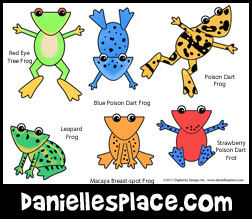
Types of Frogs - Explore different types of frogs with your students and have them color the frogs on the activity sheet to match the frogs you have studied. Have them write the names of the frogs next to the pictures of the frogs.
©2011, Digital by Design, Inc. -See Copyright Information
Sock Tadpole Craft for Kids
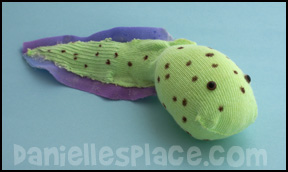
You can find the directions for this craft on the Sock Crafts For Kids Page.
©2010, Digital by Design, Inc. -See Copyright Information
Printable Frog Book
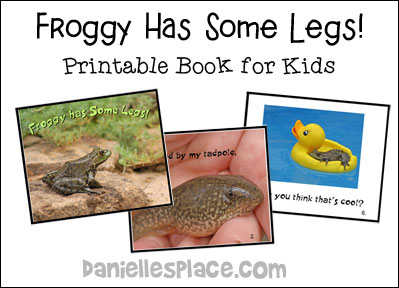
Narrated with short rhyming text this book includes facts about the difference between frogs and toads, and a page on which your child can add even more frog facts.
Froggy Has Some Legs!
Froggy has some legs!
He used to be my tadpole,
and I kept him in a bowl.
But now that he's a frog,
He swims in my pool!
Don't you think that's cool?
©2010, Digital by Design, Inc. -See Copyright Information
Frog on a Lily Pad with Paper Flower
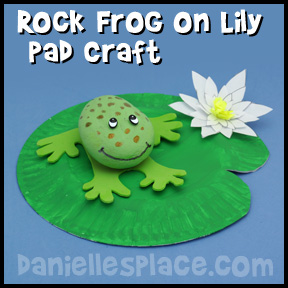
What you will need:
Smooth River Rocks
Heavy Duty Paper Plates
How to Make this Frog on a Lily Pad:
1. Paint a smooth rock and the back of the paper plate green and let it dry. When the paint is dry use markers or paint to add details.
2. Glue on eyes.
3. Cut out feet shapes from craft foam or green cards stock as shown in the picture above (or use the Pattern that is available to members). Glue the rock on top of the feet and then glue the frog on the paper plate. Use a black marker to draw in the mouth.
4. To make the lily flower cut four flower shapes from paper each one smaller than the next. To make the inside of the flower color a small rectangle shape yellow on both sides. Cut slits down the length of the rectangle about half way to the other side. Roll up the rectangle and glue it closed on the uncut side.
5. Glue the flower pieces together by overlapping the center of each piece in the center. Then glue the flower together one on top of the other. Cut the end of the rolled up rectangle and glue it to the center of the flower. (Patterns for the Lily are available to members.)
©2004, Digital by Design, Inc. -See Copyright Information
Read it! Read it! Read it! Frog Bookmarks
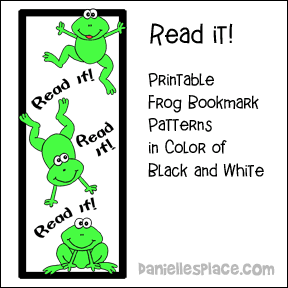
Encourage your children to read more books about Froggy by Jonathan London and have them use this frog bookmark to keep track of how many books they have read. Have them color a frog each time they read a book about frogs. You can give them a frog prize when they have colored in all three frogs.
To view pictures of the books Jonathan London has written go to his web site. You will also find a printable connect-the-dots work sheet, a hidden picture activity sheet, and which-picture-is-different activity sheet.
The Pattern for this Bookmark is available to members only.
©2005, Digital by Design, Inc. -See Copyright Information
Frog Math Activities
Measuring Distance with Plastic Frogs
Have a frog-leaping race with Jumping Frogs Toys. Give each child a plastic frog and let him practice making it leap by pressing down on its back. Then start the race. Have the children take turns measuring how far their frog leaps using a measuring tape. Write down each distance on the board.
Bulletin Board Ideas
Leap into Learning! Bulletin Board Display

This bulletin board is found on the Members Only Section of Danielle's Place.
Go to Froggy Goes to School Crafts and Learning Activities for Children.
Good Books About Frogs, Toads, and Tadpoles
Look Out for the Big Bad Fish! by Sheridan Cain
It's a beautiful summer day, but Tadpole isn't happy. Tadpole wants to be able to leap and jump like his mother and the lamb who comes to the pond to drink. They tell him that he will be able to jump when he gets a little older, but Tadpole wants to jump now. Throughout the summer he meets other creatures that can jump, and he wishes he could jump like them. Finally one day he meets the Big Bad Fish. Tadpole asks the fish if he can jump. The fish boomed, "No, but I do eat tadpoles! Tadpole leaped so high that he leapt higher than the lamb, the rabbit, and the grasshopper. He leapt all the way back home to his mom.
Learning Activities
1. How Far Can You Jump? - Draw a line somewhere that you can leave it permanently such as in your garage or basement. Have your child stand behind the line and jump as far as he can. Draw a mark on the place he landed and write a date on the line. Tell your child that you will measure how far he can jump every couple of weeks to see how fast he is growing.
2. Make Torn-paper Collage - The artist of this book used torn paper to make the illustrations.
"Working Frog" Zoo Display Learning Activity
Children pretend to be a zookeepers and keep records of the zoo's animals.
This activity goes with the book Working Frog by Nancy Winslow Parker

What you will need:
A Large Card Board Box
Artificial Leaves
Blue Plastic Wrap or Blue Fabric
Rocks, Twigs and/or Branches
Tape, Paper, Pencil, Scale, Ruler and Scissors
How to make:
1. Read the book "Working Frog" by Nancy Winslow Parker about a frog that is captured and taken to a zoo to work in an exhibit. It is a great book for children to learn about the behind-the-scene workings of a zoo.
2. Make the Frog Beanbag (below) for your habitat
Let your children be creative and pick any color they would like, make up a make-believe species, and name their frogs, or use this project as an activity to learn more about specific frog species. Study different types of frogs and make a frog that looks like one of the frogs you study. You can even make more than one type of frog.

Your child can pretend to capture the frog and bring him to the zoo. Fill out the card with information about his frog like the zookeeper did in the book. Include the place of origin, who caught the frog, and the date. He can also pretend to examine the frog, weigh him, and measure him, and write the information on a card. You can make up your own forms or use the forms available to members only on the Activities and Crafts for Popular Children's Books Page.
3. Make a frog exhibit - Find a large box and help your child cut the sides out to look like an aquarium leaving about one inch on all edges. Leave the flaps on the top. Let your child use different materials to make the display. Discuss what would be found in a pond habitat. You can also get books about pond habitats at the library so that you have pictures to work from. When the exhibit is done, place the frog inside. Make a form to be place on the tank like the one pictured in the book. Include the tank number, temperature, name of the animal and the acquisition number from the first form that was filled out. Also make a feeding table including the date fed, diet, what he ate that day, and any notes about the animal. This form is available to members.
This activity can also be used with live animals. You can create a whole zoo with animals such as hermit crabs, preying mantis, ladybugs, frogs, crickets, worms, caterpillars, gerbils, spiders, etc.
©2005, Digital by Design, Inc. -See Copyright Information
Science
1. Make an Animal Habitat

See the Frog Crafts Page for directions. Have your child pretend to be a zookeeper and fill out the Acquisition Forms and Tank Forms. He can keep the acquisition forms in a folder and tape the tank forms to the displays. Your child can make more than one display using toy animals, animals he makes, or real, live animals. For each animal research where they can be found and their habitat, what they eat, and fill out a form for each animal.
2. Research other Animals. On page 37 Winston said there was also a Giant Toad, a Reticulated Python, and a Timber Rattlesnake in the zoo with him. Look up these animals on the Internet to find out more information about them.
3. Find out what amphibians and reptiles are.
4. Visit your local zoo.
5. Get your child's friends together and have them bring their animals to set up a zoo of their own. Invite your friends over. Let each child tell about his particular animal.
Math
1. Figure out how many people altogether came to peer at Winston the frog. Page 36 tells how many boys, girls, mothers, fathers, and teachers came to look at Winston. Have your child add them up to determine how many came altogether the first day. You can also make up a graph showing how many people came each day for a week and make up questions like:
1. On what day did the most people come to see Winston?
2. On what day did the least amount of people come?
3. How many people came during the whole week?
4. What was the average amount of people to come in one day?
Writing
1. Write a story about an animal that is captured and taken to the zoo using the book as a model. Tell children to pick an animal they would like to use in their story. Tell them to pretend to be that animal and think about what it would be like to be that animal, to be captured and taken to a zoo.
Use the same setup as the story, the first part of the story should be where the animal was captured, pond, river, desert, lake, etc and how he felt on his trip to the zoo. The story should be written in the point of view of the animal using the word "I" throughout the story.
The second chapter should be about arriving at the zoo, what the zookeeper did and how he felt in a strange new place.
The third chapter should be about settling into his new life and why he was there.
The fourth chapter should be about how he accepts or doesn't accept his new life as a working animal and the conclusion to the story.
©2000, Digital by Design, Inc. - See Copyright Information
Frog Beanbags
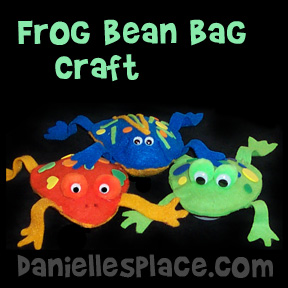
What you will need:
Felt Squares
Pompoms (optional)
Goodly eyes
Tacky Glue or Elmer's Tacky Glue
Scissors
Rice or Dried Beans to Fill the Bean Bags
How to make Frog Beanbags:
1. Print out the pattern for the body and legs and cut them out. Use them to cut the shapes from felt.
2. Glue the legs and arms to one of the body shapes as shown in the picture. Glue the other body piece on top of the piece with the legs and arms attached. Leave an opening at the back of the frog.
3. Fill the body with bean, rice, popcorn, or fiberfill. Glue the body closed.
4. You can glue goodly eyes to pompoms and then glue the pompoms onto the frog or just glue goodly eyes onto the frog without using the pompoms.
5. Decorate the frog with fun foam shapes, beads, pieces of cut up felt, buttons, or anything else you can find.
Frog Toss Math Game
Before class make some frog beanbags and cut out some lily pad shapes from construction paper. Write numbers on the lily pads and tape them to the floor. Write your children's name on the board. Let them take turns throwing the beanbag frogs onto the lily pads and then adding up their score. You can make this game appropriate for any grade level. If you have younger children, use smaller numbers and have them add them together. Each child should add his own score. If you have older children, you can practice multiplication families by having them multiply the numbers on the lily pad by a certain number and then add the answer to their score.
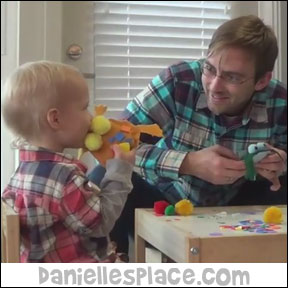

This is a great craft to work on fine motor skills and reviewing colors and shapes with your toddler.
Two-year-old Logan had a lot of fun making the frog bean bag craft. He did a great job helping his dad pour the beans into the frog using a large funnel.
He enjoyed the soft texture of the large pompoms. He played with the pompoms and reviewed the names of colors while his father cut out the felt shapes.
He liked the completed frog so much that he gave it a kiss.
Find out more and watch video showing how they made the craft on Logan's Life.
©2005, Digital by Design, Inc. -See Copyright Information
Frog Crafts on Other Pages
Frog Crafts on Other Pages



